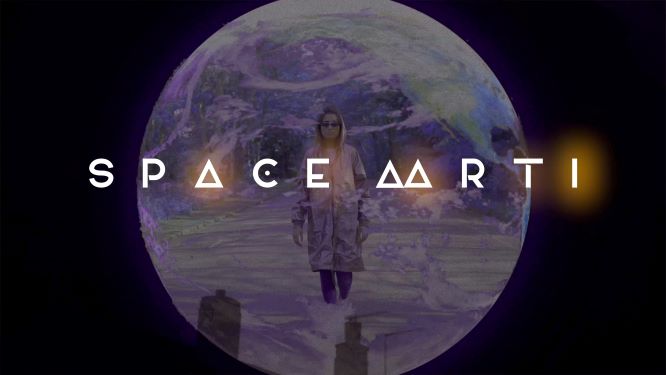‘Space Aarti’ is the newest creation of Narvir Singh, a regular collaborator at naujawani who goes by the moniker Narvision. This music song-video combination is released on the day of Guru Nanak’s Gurpurab and is made to celebrate and instigate conversation about the subject matter. I deemed the work review-worthy for that reason, coupled with the unique looking visuals and lyrical content.
Narvir Singh is a spoken word poet, artist and film-maker who is not shy about pushing boundaries with his art. He is a creative in the truest sense, unrestrained by labels, producing work that blurs the lines between differing disciplines. ‘Space Aarti’ epitomises that and is in many ways a departure from his most recent musical offerings, ‘1989’ and the EP ‘Trucks and Textiles‘, most notably as this work is just as much about the video as it is the music.
‘Space Aarti’ is based on the subject matter contained within the Aarti – a bani read at the close of the day in the Guru’s Darbar. Sikhs reading this review have probably heard the Aarti many times, even without realising it; a popular rendition by kirtani Bhai Harjinder Singh Sri Nagar can be found here. The ‘Aarti’ is an homage to the infinite creative power of Divinity, presenting the planets and astral objects as being an offering to the Almighty on the canvas that is space. The reimagined ‘Aarti’ of the House of Guru Nanak takes the traditional sub-continental aarti performed through pooja and reorients our notions of worshipping in this manner. There have been attempts to explain the ‘Aarti’ in English – the mmost obvious being the interpretations that appear on phone apps and projector screen slides in Gurdwareh. However, few have made efforts to interpret the bani for new generations through the broader medium of art and this is what gives ‘Space Aarti’ importance.
Both technically and aesthetically, the music video is stunning, brimming with segments of neon colour on a backdrop of filtered greys. Costumes in shimmering silver and heightened tones on brown faces provide the video with a unique look that speaks more of futurism than the western-based Sikh devotional visuals that viewers woill have seen from mainstream musical artist. The piece is something of an acquired taste and will not be to everybody’s liking, but one can’t deny the apt setting for what is deep subject matter. The music is ethereal, driving the record constantly in a depiction of the rhythmic patterns of the Universe. Whilst it could be said that the melody and beat is thus largely unadventurous, it provides a naturally fitting accompaniment to Narvir Singh’s vocals and is the first published piece by Deep Singh. What Narvir Singh’s past work has lacked in mastering, this record has gone a long way to rectify with an audibly clearer vocal sound that allows lyrics to be carefully discerned. The two verses interpreting the ‘Aarti’ surround a single line of Gurbani sung ably by Jagdish Kaur who is the second character in the music video – unsurprisingly the two combine well both vocally and visually (theya re husband and wife!)
Lyrics such as “I’m just star-dust, what’s the consolation? // Beauty of life, in star constellations” is as concise and catchy a lyric that one can find in English espousing Guru Nanak’s philosophy of ੴ, of living in this World but not becoming of it, and finding salvation through embracing life instead of rejecting it. Elsewhere “Pulsar light fuels my inspiration // Slice of Mars, land for my nation” opens a conversation that is not widely had on the role of the nation state in a multi-planetary system, providing a platform for the likes of me at least to talk more on why redefining Statehood in a 21st Century world is vital for the Sikh nation. I can’t be alone in wanting to further the conversation having heard ‘Space Aarti’; what will be most fascinating to see is whether other artists will consider doing something alonge the same lines.
Interpreting the Guru Granth Sahib – that is understanding the Shabad through discourse – dates back to the times of Guru Nanak himself and though the main source of this was katha (sermons) upon which the sangat would then go on to deliberate in their own time, it is not something that has become commonplace as Sikhs moved out of the Punjab and took on the English language as their lingua franca. This needs to change, not least because the English interpretations that have been published and are erroenously termed ‘translations’ are outdated. What we understand about various bani from within the Guru Granth Sahib that has come to us through the English language should be the spark for conversation; an instigator and not a finite meaning which can only truly come from reading the Shabad itself. ‘Space Aarti’ is an excellent step in this regard for a generation that seeks short, sharp and snappy soundbites when consuming content online.
‘Space Aarti’ is available now on Youtube at: https://youtu.be/N0dH5ApDklo







